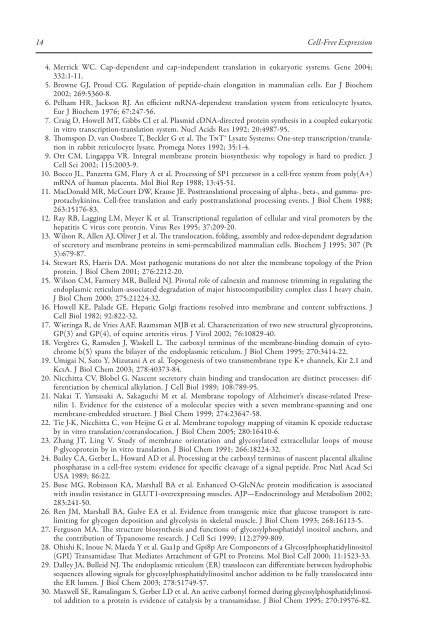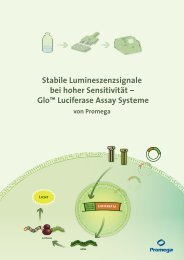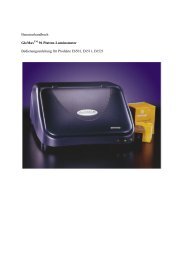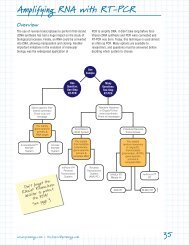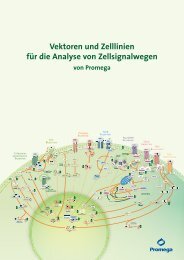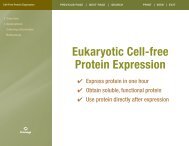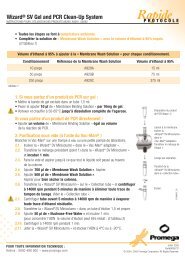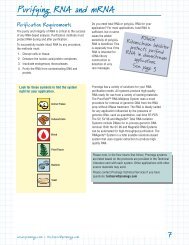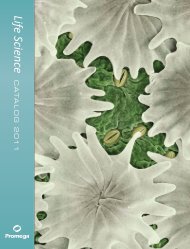The Role of Cell-Free Rabbit Reticulocyte Expression ... - Promega
The Role of Cell-Free Rabbit Reticulocyte Expression ... - Promega
The Role of Cell-Free Rabbit Reticulocyte Expression ... - Promega
You also want an ePaper? Increase the reach of your titles
YUMPU automatically turns print PDFs into web optimized ePapers that Google loves.
1 <strong>Cell</strong>-<strong>Free</strong> <strong>Expression</strong><br />
4. Merrick WC. Cap‑dependent and cap‑independent translation in eukaryotic systems. Gene 2004;<br />
332:1‑11.<br />
5. Browne GJ, Proud CG. Regulation <strong>of</strong> peptide‑chain elongation in mammalian cells. Eur J Biochem<br />
2002; 269:5360‑8.<br />
6. Pelham HR, Jackson RJ. An efficient mRNA‑dependent translation system from reticulocyte lysates.<br />
Eur J Biochem 1976; 67:247‑56.<br />
7. Craig D, Howell MT, Gibbs CI et al. Plasmid cDNA‑directed protein synthesis in a coupled eukaryotic<br />
in vitro transcription‑translation system. Nucl Acids Res 1992; 20:4987‑95.<br />
8. Thomspon D, van Oosbree T, Beckler G et al. <strong>The</strong> TnT® Lysate Systems: One‑step transcription/transla‑<br />
tion in rabbit reticulocyte lysate. <strong>Promega</strong> Notes 1992; 35:1‑4.<br />
9. Ott CM, Lingappa VR. Integral membrane protein biosynthesis: why topology is hard to predict. J<br />
<strong>Cell</strong> Sci 2002; 115:2003‑9.<br />
10. Bocco JL, Panzetta GM, Flury A et al. Processing <strong>of</strong> SP1 precursor in a cell‑free system from poly(A+)<br />
mRNA <strong>of</strong> human placenta. Mol Biol Rep 1988; 13:45‑51.<br />
11. MacDonald MR, McCourt DW, Krause JE. Posttranslational processing <strong>of</strong> alpha‑, beta‑, and gamma‑ pre‑<br />
protachykinins. <strong>Cell</strong>‑free translation and early posttranslational processing events. J Biol Chem 1988;<br />
263:15176‑83.<br />
12. Ray RB, Lagging LM, Meyer K et al. Transcriptional regulation <strong>of</strong> cellular and viral promoters by the<br />
hepatitis C virus core protein. Virus Res 1995; 37:209‑20.<br />
13. Wilson R, Allen AJ, Oliver J et al. <strong>The</strong> translocation, folding, assembly and redox‑dependent degradation<br />
<strong>of</strong> secretory and membrane proteins in semi‑permeabilized mammalian cells. Biochem J 1995; 307 (Pt<br />
3):679‑87.<br />
14. Stewart RS, Harris DA. Most pathogenic mutations do not alter the membrane topology <strong>of</strong> the Prion<br />
protein. J Biol Chem 2001; 276:2212‑20.<br />
15. Wilson CM, Farmery MR, Bulleid NJ. Pivotal role <strong>of</strong> calnexin and mannose trimming in regulating the<br />
endoplasmic reticulum‑associated degradation <strong>of</strong> major histocompatibility complex class I heavy chain.<br />
J Biol Chem 2000; 275:21224‑32.<br />
16. Howell KE, Palade GE. Hepatic Golgi fractions resolved into membrane and content subfractions. J<br />
<strong>Cell</strong> Biol 1982; 92:822‑32.<br />
17. Wieringa R, de Vries AAF, Raamsman MJB et al. Characterization <strong>of</strong> two new structural glycoproteins,<br />
GP(3) and GP(4), <strong>of</strong> equine arteritis virus. J Virol 2002; 76:10829‑40.<br />
18. Vergères G, Ramsden J, Waskell L. <strong>The</strong> carboxyl terminus <strong>of</strong> the membrane‑binding domain <strong>of</strong> cyto‑<br />
chrome b(5) spans the bilayer <strong>of</strong> the endoplasmic reticulum. J Biol Chem 1995; 270:3414‑22.<br />
19. Umigai N, Sato Y, Mizutani A et al. Topogenesis <strong>of</strong> two transmembrane type K+ channels, Kir 2.1 and<br />
KcsA. J Biol Chem 2003; 278:40373‑84.<br />
20. Nicchitta CV, Blobel G. Nascent secretory chain binding and translocation are distinct processes: dif‑<br />
ferentiation by chemical alkylation. J <strong>Cell</strong> Biol 1989; 108:789‑95.<br />
21. Nakai T, Yamasaki A, Sakaguchi M et al. Membrane topology <strong>of</strong> Alzheimer’s disease‑related Prese‑<br />
nilin 1. Evidence for the existence <strong>of</strong> a molecular species with a seven membrane‑spanning and one<br />
membrane‑embedded structure. J Biol Chem 1999; 274:23647‑58.<br />
22. Tie J‑K, Nicchitta C, von Heijne G et al. Membrane topology mapping <strong>of</strong> vitamin K epoxide reductase<br />
by in vitro translation/cotranslocation. J Biol Chem 2005; 280:16410‑6.<br />
23. Zhang JT, Ling V. Study <strong>of</strong> membrane orientation and glycosylated extracellular loops <strong>of</strong> mouse<br />
P‑glycoprotein by in vitro translation. J Biol Chem 1991; 266:18224‑32.<br />
24. Bailey CA, Gerber L, Howard AD et al. Processing at the carboxyl terminus <strong>of</strong> nascent placental alkaline<br />
phosphatase in a cell‑free system: evidence for specific cleavage <strong>of</strong> a signal peptide. Proc Natl Acad Sci<br />
USA 1989; 86:22.<br />
25. Buse MG, Robinson KA, Marshall BA et al. Enhanced O‑GlcNAc protein modification is associated<br />
with insulin resistance in GLUT1‑overexpressing muscles. AJP—Endocrinology and Metabolism 2002;<br />
283:241‑50.<br />
26. Ren JM, Marshall BA, Gulve EA et al. Evidence from transgenic mice that glucose transport is rate‑<br />
limiting for glycogen deposition and glycolysis in skeletal muscle. J Biol Chem 1993; 268:16113‑5.<br />
27. Ferguson MA. <strong>The</strong> structure biosynthesis and functions <strong>of</strong> glycosylphosphatidyl inositol anchors, and<br />
the contribution <strong>of</strong> Typanosome research. J <strong>Cell</strong> Sci 1999; 112:2799‑809.<br />
28. Ohishi K, Inoue N, Maeda Y et al. Gaa1p and Gpi8p Are Components <strong>of</strong> a Glycosylphosphatidylinositol<br />
(GPI) Transamidase That Mediates Attachment <strong>of</strong> GPI to Proteins. Mol Biol <strong>Cell</strong> 2000; 11:1523‑33.<br />
29. Dalley JA, Bulleid NJ. <strong>The</strong> endoplasmic reticulum (ER) translocon can differentiate between hydrophobic<br />
sequences allowing signals for glycosylphosphatidylinositol anchor addition to be fully translocated into<br />
the ER lumen. J Biol Chem 2003; 278:51749‑57.<br />
30. Maxwell SE, Ramalingam S, Gerber LD et al. An active carbonyl formed during glycosylphosphatidylinosi‑<br />
tol addition to a protein is evidence <strong>of</strong> catalysis by a transamidase. J Biol Chem 1995; 270:19576‑82.


